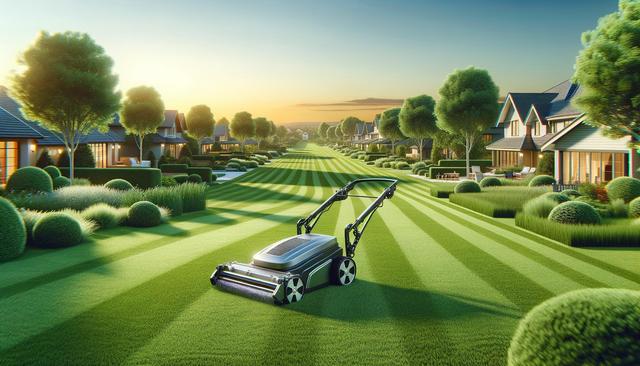From Manual Mowing to Autonomous Precision
For decades, mowing the lawn has been a routine yet time-consuming chore for homeowners and groundskeepers alike. Traditional lawnmowers, whether gas-powered or electric, required manual operation, regular maintenance, and physical effort. However, the emergence of grass cutter robots is redefining this process by introducing a level of automation that was once only imagined. These robotic lawn mowers use sensors, GPS, and programmable settings to navigate yards with remarkable accuracy, significantly reducing the time and effort needed for upkeep.
This transition from manual to autonomous mowing is part of a broader trend seen in smart home and outdoor technologies. Grass cutter robots are designed to handle various terrains, adapt to lawn sizes, and even return to their docking stations when their batteries run low. The convenience they offer is not only a matter of saving time but also of enhancing precision in lawn care, ensuring consistent grass height across the yard without human error.
How Grass Cutter Robots Work
Understanding the functionality behind these devices helps illustrate why they’re gaining popularity. A typical grass cutter robot operates using a combination of boundary wires, onboard sensors, and a powerful cutting system. The boundary wire, often installed around the perimeter of the lawn, guides the robot’s movement, preventing it from straying into unwanted areas like flower beds or driveways.
Key features of grass cutter robots include:
- Automated scheduling for daily or weekly mowing
- Rain sensors to avoid mowing during wet conditions
- Adjustable cutting heights and patterns
- Anti-theft systems with alarms and PIN codes
Many models also come equipped with mobile app integration, allowing users to control and monitor the mower remotely. Some advanced units utilize GPS mapping to optimize coverage and avoid repetitive patterns. These features collectively ensure that the lawn is consistently maintained with minimal manual intervention.
Benefits for Homeowners and Property Managers
The advantages of grass cutter robots extend beyond mere convenience. For homeowners, these devices offer a way to maintain a visually appealing yard with minimal effort. Property managers overseeing larger estates or commercial spaces benefit from operational efficiency and reduced labor costs. Additionally, many robotic mowers are electric, making them quieter and more environmentally friendly compared to traditional gas-powered mowers.
Some of the key benefits include:
- Lower noise levels, ideal for early morning or evening operation
- Reduced emissions contributing to a cleaner environment
- Consistent lawn appearance without human error
- Less time spent on manual labor, freeing up resources
These advantages make grass cutter robots an appealing option for a wide range of users, from tech-savvy homeowners to professional landscapers looking to modernize their services.
Challenges and Considerations
Despite their many advantages, adopting grass cutter robots does come with certain challenges. Initial installation can be complex, particularly when laying boundary wires or configuring the device to suit specific lawn features. Uneven terrain, steep slopes, and dense vegetation can also affect performance, though newer models are increasingly equipped to handle such conditions.
Other considerations include:
- Higher upfront costs compared to manual mowers
- Maintenance of blades and periodic software updates
- Security concerns if the device is used in unsecured areas
While these issues may deter some potential users, ongoing innovations in design and technology are gradually addressing many of these limitations. As products evolve, they are becoming more accessible and easier to integrate into a variety of outdoor spaces.
The Future of Robotic Lawn Care
Looking ahead, the future of lawn care is poised to become even more automated and intelligent. Manufacturers are exploring the use of AI and machine learning to improve navigation and efficiency. Integration with smart home ecosystems may soon allow grass cutter robots to communicate with weather systems, irrigation controls, and other outdoor devices, creating a fully automated garden management system.
Expect to see developments such as:
- Enhanced obstacle detection using computer vision
- Dynamic path planning based on real-time data
- Eco-friendly battery technologies with longer lifespans
- Voice assistant compatibility for easier control
These innovations could make robotic lawn care more adaptable, user-friendly, and sustainable. As the technology matures, it’s likely that grass cutter robots will become a standard component in residential and commercial landscaping solutions.
Conclusion: Embracing the Innovation in Lawn Maintenance
Grass cutter robots represent a significant leap forward in outdoor technology, offering a practical and eco-conscious solution for modern lawn maintenance. For homeowners seeking convenience and uniformity, or for property managers aiming to streamline operations, these devices provide a compelling alternative to traditional mowing methods. As adoption grows and features become more advanced, grass cutter robots are set to become an integral part of the future of landscaping. By embracing this innovation, users can enjoy a well-maintained lawn with less effort, reduced environmental impact, and more time for the things that matter most.






